Steering quality can make or break any vehicle. If a vehicle “doesn’t drive right,” it’s a constant source of irritation for the driver and certainly for the alignment technician who’s trying to correct the complaint. What is steering quality? While other technicians might have their own definitions of steering quality, my definition is, in essence, a sensitivity of the steering system to inputs from the road and outputs from the driver. Even when the tires wear perfectly and the steering system is in otherwise good condition, poor steering quality can ruin what should be an otherwise good driving experience.
EARLY DESIGNS
In the years before rack-and-pinion steering gears were popularly introduced, most imports incorporated what is popularly known as a parallelogram steering linkage system into their chassis designs. In this system, a steering arm attached to the steering gear supports the steering linkage on the driver’s side, while an idler arm assembly attached to the frame supports the steering linkage on the passenger’s side. The steering and idler arms form a rectangle in the straight-ahead position. As the front wheels turn in one direction or the other, the configuration with the chassis changes from a rectangle to a parallelogram.
Although variations of parallelogram steering linkages can be found today in many import truck, sport-utility and high-end luxury vehicle designs, most modern import passenger cars use the rack-and-pinion steering systems. In these systems, the steering gear actually becomes part of the steering linkage. Because of this factor, rack-and-pinion steering systems tend to be more responsive, with fewer wear points and less deflection than conventional parallelogram steering linkages.
HOW STEERING GEARS AFFECT STEERING QUALITY
To experience good steering quality, the driver must sense when the front wheels are pointed straight ahead. To accomplish this, a steering gear achieves zero gear lash in the “over-center” or straight-ahead position. This tightening of gear lash lets the driver feel the exact point where the steering wheel returns to center.
If the steering wheel position doesn’t match the straight-ahead position of the front wheels, the driver subconsciously loses his sense of steering position. To illustrate, if the steering gear allows three turns of the steering wheel lock-to-lock, actual over-center or zero lash should occur at 1.5 turns from either the right or left limit of travel. If the driver must turn the steering wheel to compensate for incorrect wheel tracking, the steering gear begins to operate “off-center” and the driver again loses his sense of steering position.
Steering gear adjustments are quite important to establishing steering quality in parallelogram steering systems. Manual gears have a steering shaft bearing adjustment that uses shims or an adjustable threaded end cap to eliminate end play from the steering shaft bearings. Excess end play in the steering shaft bearings causes a lack of steering response in the steering wheel. At the other extreme, excess bearing preload causes the steering wheel to become unresponsive to driver and road inputs.
Although they seldom require adjustment, many rack-and-pinion steering gears have a similar “high point” ground into the rack gear to provide a firm sense of steering position. Because loose steering rack mounting bushings allow the rack to move in relation to the chassis, the loose bushings will cause the vehicle to wander, even while the driver has a firm grasp of the steering wheel.
THE THEORY OF STEERING DAMPENERS
Steering dampeners are found only on parallelogram steering systems or I-beam front axle assemblies. The old I-beam front axle assemblies are especially susceptible to wheel shimmy because, as the spring bushings, steering gears and steering linkages wear out, the wheels tend to steer independently of the steering wheel.
A wheel shimmy occurs when one of the front wheels begins fighting with the other front wheel for directional control of the vehicle. So, as the wheels strike a bump or washboard condition in the road, the front wheels begin to violently oscillate from left to right. In most cases, the shimmy can be controlled only by slowing down or by firmly applying the brakes to dampen the vibration.
Although steering dampeners were originally designed to dampen the resonances causing steering wheel shimmy, it became apparent that they would also reduce the tendency of a pothole to tear the steering wheel from the driver’s grasp. Most important on late-model vehicles, a steering dampener also dampens inputs to the steering wheel caused by minor irregularities in the road surface.
Although steering dampeners seldom fail outright, they do degrade over time from wear and fluid leakage. In some cases, the dampener might even develop more resistance to turning in one direction than the other, which again causes an annoying, but hard to diagnose, steering quality issue.
A steering dampener should be visually inspected for physical damage or fluid leakage. If the damper passes a visual inspection, remove the dampener and test it by hand for equal resistance on its compression and extension strokes. If in doubt, compare these dampening qualities to those of a new dampener.
WHEEL ALIGNMENT AND STEERING QUALITY
Due to local road conditions and the individual ways people load their vehicles, aligning all four wheels has become as much of an art as it is a science. But, in general, the best steering quality is found when the caster and camber angles are of equal values.
Toe-in angle is perhaps the most important determinant of steering quality. In general, toe angle is adjusted so that total toe-in becomes zero under most loading and driving conditions. Front-wheel-drive vehicles generally start with a negative to zero toe angle that increases, under dynamic driving conditions, to a positive value when thrust is applied to the front driving wheels. Rear-wheel-drive vehicles generally begin with a positive toe angle on the front tires, that’s reduced by rolling friction under dynamic driving conditions to a slightly positive or zero value.
In general, positive toe angle prevents the wheels from following ruts and irregularities in the road surface. Negative toe angle generally creates a quick steering response that, in turn, increases tie wear and the tendency to follow ruts in the road. In most cases, negative toe angle is caused by bent tie rods, loose tie rod ends, worn ball joints or unusual changes in vehicle ride height.
Steering axis inclination (SAI) was originally incorporated into steering geometry to improve steering quality by reducing the amount of road shock transferred into the steering wheel. SAI is the angle formed between a line drawn through the upper and lower pivot points of the steering knuckle and the horizontal line of the spindle. When the steering is turned lock to lock, it’s easy to see the change in side-to-side suspension height created by SAI and caster angle working together.
Because SAI uses the vehicle’s weight to return the steering wheel to center when released, a major variation between driver- and passenger-side SAI caused by a bent spindle might reduce the sense of steering wheel centering. Similarly, a bent steering arm, which controls the turning radius of the inside and outside wheels, might reduce the sense of steering reaction when turning in one direction or the other.
Differences in wheel base (also called wheel offset) might also create an annoying difference in the turning radius between right- and left-hand turns. Wheel offset can be caused by uncorrected collision damage or by a shifted engine cradle on front-wheel-drive vehicles. If the vehicle has undergone an engine or transmission replacement, a misaligned engine cradle is the most likely cause of differences in wheel offset.
DIAGNOSTIC SUMMARY
I’ve ignored the effect that struts, shock absorbers, tire designs and casing defects can have on steering quality because they are a story unto themselves. Regarding the cumulative effects that minor mechanical issues can have on steering quality, it’s important to understand that a loss of steering quality is generally caused by the degradation of the entire steering and suspension system.
The first step in restoring steering quality is to thoroughly inspect steering and suspension parts for cumulative wear. Observing the toe angle change caused by applying hand pressure to the front and rear insides of the tires is a good way to test for cumulative wear in the tie rod ends. The second step is to measure all of the alignment angles, including chassis thrust line angles. If the wheels aren’t aligned with the thrust line of the vehicle, an accurate centering of the steering gear can’t be achieved under dynamic conditions and steering quality will suffer.
Steering Geometry
I’ve chosen a classic I-beam front axle to illustrate steering geometry angles that aren’t normally visible during the inspection and alignment process. Basic steering geometry hasn’t changed in 50 years and each of these angles is important to establishing good steering quality.
The dampening piston on a steering stabilizer must be centered and the stabilizer itself must be nearly parallel with the steering linkage when the front wheels are in the straight-ahead position. The inward tilt of the kingpin on this classic solid axle forms an angle that should intersect with the center of the contact patch on the tire.
Steering Axis Inclination (SAI) is represented by the angle formed between the kingpin and spindle. On modern vehicles, this angle is established through the upper strut support bearing and lower ball joint. To establish correct wheel tracking around corners, an angle drawn through the steering arm should intersect with the center of the rear axle. Front-mounted steering arms should intersect at an equivalent distance in front of the vehicle.
The steering arm on this classic chassis is at the vertical position when the front wheels are centered. Modern parallelogram steering systems are similar because the pivot points of the steering arm and idler arm should be parallel to the chassis when the front wheels are centered.
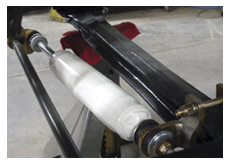 |
|
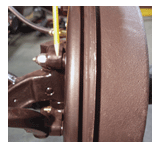 |
|
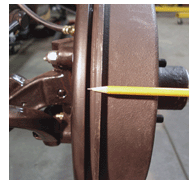 |
|
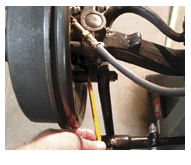 |
|
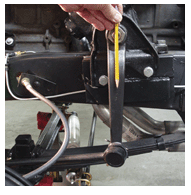 |












